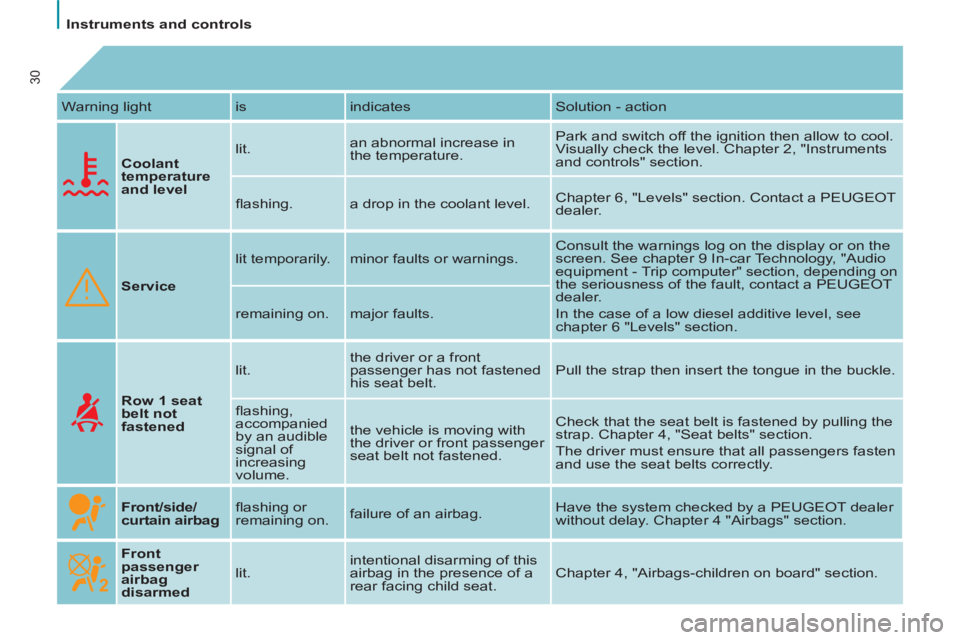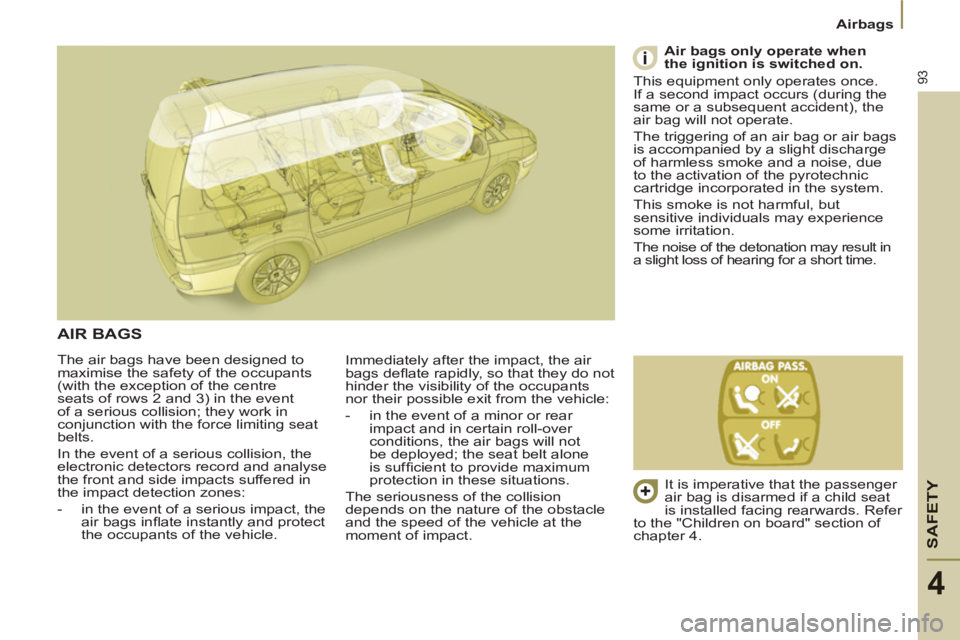2013 Peugeot 807 airbag
[x] Cancel search: airbagPage 4 of 234

2
Contents
4. SAFETY 85-102
Driving safety 86
Handbrake 86
Hazard warning lights 86
Parking assistance 87
ABS and EBFD 88
Horn 88
Emergency braking
assistance 88
ASR and ESP 89
Tyre under-infl ation
detection 90
Seat belts 91
Airbags 93
Passenger air bag
disarming 93
Child seats 97
Isofi x seats 99
Recommended seats 100
Monitoring mirror 102 Steering wheel
controls 43
Lighting 43
Windscreen wipers 46
Cruise control 48
Speed limiter 51
Ventilation 54
De-icing and demisting 55
Seats 59
Front 59
Rear 64
Bench seat 69
Modularity 71
Comfort and safety 75
Layout 75
Courtesy lights 80
Sun visor 81
Mirrors and windows 82
3. EASE OF USE and
COMFORT 43-84
Presentation 4
Communication 4
Exterior 6
Interior 8
Identifi cation features 17
1. FAMILIARISATION 4-17
Accesses 18
Keys 18
Alarm 22
Doors 23
Child safety 25
Tailgate 25
Sunroofs 26
Instruments and controls 27
Control block 27
Instrument panels 28
Warning lights 29
Indicators, Display 34
Gearbox
Automatic 37
Manual 41
Steering
wheel adjustment 41
Starting and stopping 42
2. READY
TO SET OFF 18-42
Page 11 of 234

9
1
FAMILIARISATIO
N
Interior
13.
Battery / Fuse box.
14.
Passenger airbag.
15.
Passenger's lower glove box / Fuse
box / RCA sockets.
16.
Air conditioning controls.
17.
Lighter /
12 V accessories socket.
18.
Hazard warning lights switch.
19.
Storage compartment or additional
telematics control.
20.
Cooled compartment.
21.
Ashtray / Can holder.
22.
Seat adjustment control.
23.
Storage compartment.
24.
Handbrake - on the left.
1.
Electric mirror controls.
- Electric window controls.
- Deactivation of the rear electric
controls.
2.
Driver's upper glove box.
3.
Central adjustable vents.
4.
Audio equipment or GPS
multimedia audio equipment with
fl ap.
5.
Instrument panel / Large colour
display.
6.
Sunshine and passenger
compartment temperature sensor.
7.
Passenger's upper glove box.
25.
Bonnet release under cover - on
the left.
26.
Acoustic windscreen.
INTERIOR OVERVIEW
SETTING THE DATE AND
TIME
For more information about
this adjustment, refer to the
"Setting the date and time" section of
the "In-car technology" chapter.
ADDITIONAL HEATER
With the engine at idle
or when the vehicle is
stationary, it is normal
to notice a high-pitched
whistling and a slight emission of
smoke and odour.
Bluetooth.
8.
Windscreen demisting vents.
9.
Speaker (tweeter).
10.
Front window demisting vents.
11 .
Passenger airbag disarming switch,
if fi tted on your vehicle.
12.
Side adjustable vent.
Page 12 of 234

10
Interior
5.
Control block.
6.
Steering wheel audio equipment
controls.
7.
Wipers / wash-wipe / trip computer
controls.
8.
Gear lever.
9.
Ignition.
1.
Interior protection alarm
deactivation button.
2.
Speed limiter / cruise control
switches.
3.
Lights and direction indicators
controls.
4.
Driver's airbag.
Horn.
10.
Headlamp height adjustment.
11 .
a- Dynamic stability control button
(ESP/ASR).
b- Parking assistance button.
12.
Steering wheel adjustment control.
INSTRUMENTS AND CONTROLS
Page 17 of 234

4
244
7
6
4 3 3
415
1
FAMILIARISATIO
N
Interior
Battery
11 6
Child monitoring mirror
102
Disarming the passenger's front airbag
96
Opening control
Sliding side doors from the
inside. 24
Handbrake
86
Bonnet opening controls
The bonnet opening control
is a red handle under a
cover. Release the bonnet
from inside the vehicle then
go to the front and insert
your hand under the badge
to open and raise the bonnet,
place the strut in its location
securely. 111
Safety auto-reverse.
97 102 84 83
Electric windows/Safety auto-reverse
CHILD SAFETY
Monitoring mirror.
Child seats. On a steep gradient,
guide the side door
manually to assist
closing.
closing
Page 20 of 234

Access
18
REMOTE CONTROL
Deadlocking
KEY
S
Deadlocking renders the internal
and external door locking
controls inoperative. Never leave
anyone inside the vehicle when it is
deadlocked.
If the deadlocking is operated from
inside the vehicle, it will change to
normal locking when the vehicle is
started.
ACCESS
Press the closed padlock to
lock the vehicle.
This is confi rmed by fi xed
lighting of the direction
indicators for approximately
two seconds.
Central locking
From the driver’s door or passenger
door, the keys allow you to lock,
deadlock or unlock the doors and
tailgate, as well as fold back the
exterior mirrors.
If one of the doors or the tailgate is open,
the central locking does not work.
The remote control performs the
same functions at a distance.
The key allows you to switch on the
ignition and to mechanically operate
the lock on the fuel fi ller cap, the glove
box, the passenger airbag disarming
switch and the mechanical child lock.
Normal locking
If your vehicle is fi tted with
deadlocking, a second press
on the closed padlock within
fi ve seconds of locking
changes this to deadlocking.
This is confi rmed by fi xed lighting
of the direction indicators for
approximately two seconds.
Page 32 of 234

Instruments and controls
30
Warning light is indicates Solution - action
Coolant
temperature
and level
lit. an abnormal increase in
the temperature. Park and switch off the ignition then allow to cool.
Visually check the level. Chapter 2, "Instruments
and controls" section.
fl ashing. a drop in the coolant level. Chapter 6, "Levels" section. Contact a PEUGEOT
dealer.
Service
lit temporarily. minor faults or warnings. Consult the warnings log on the display or on the
screen. See chapter 9 In-car Technology, "Audio
equipment - Trip computer" section, depending on
the seriousness of the fault, contact a PEUGEOT
dealer.
In the case of a low diesel additive level, see
chapter 6 "Levels" section. remaining on. major faults.
Row 1 seat
belt not
fastened
lit. the driver or a front
passenger has not fastened
his seat belt. Pull the strap then insert the tongue in the buckle.
fl ashing,
accompanied
by an audible
signal of
increasing
volume. the vehicle is moving with
the driver or front passenger
seat belt not fastened. Check that the seat belt is fastened by pulling the
strap. Chapter 4, "Seat belts" section.
The driver must ensure that all passengers fasten
and use the seat belts correctly.
Front/side/
curtain airbag fl ashing or
remaining on. failure of an airbag. Have the system checked by a PEUGEOT dealer
without delay. Chapter 4 "Airbags" section.
Front
passenger
airbag
disarmed
lit. intentional disarming of this
airbag in the presence of a
rear facing child seat. Chapter 4, "Airbags-children on board" section.
Page 95 of 234

SAFETY
93
Airbags
4
The air bags have been designed to
maximise the safety of the occupants
(with the exception of the centre
seats of rows 2 and 3) in the event
of a serious collision; they work in
conjunction with the force limiting seat
belts.
In the event of a serious collision, the
electronic detectors record and analyse
the front and side impacts suffered in
the impact detection zones:
- in the event of a serious impact, the
air bags infl ate instantly and protect
the occupants of the vehicle. Immediately after the impact, the air
bags defl ate rapidly, so that they do not
hinder the visibility of the occupants
nor their possible exit from the vehicle:
- in the event of a minor or rear
impact and in certain roll-over
conditions, the air bags will not
be deployed; the seat belt alone
is suffi cient to provide maximum
protection in these situations.
The seriousness of the collision
depends on the nature of the obstacle
and the speed of the vehicle at the
moment of impact.
Air bags only operate when
the ignition is switched on.
This equipment only operates once.
If a second impact occurs (during the
same or a subsequent accident), the
air bag will not operate.
The triggering of an air bag or air bags
is accompanied by a slight discharge
of harmless smoke and a noise, due
to the activation of the pyrotechnic
cartridge incorporated in the system.
This smoke is not harmful, but
sensitive individuals may experience
some irritation.
The noise of the detonation may result in
a slight loss of hearing for a short time.
AIR BAGS
It is imperative that the passenger
air bag is disarmed if a child seat
is installed facing rearwards. Refer
to the "Children on board" section of
chapter 4.
Page 96 of 234

94
Airbags
Good practice
If your vehicle is fi tted with a front
passenger air bag, side air bags or
curtain air bags, observe this good
practice.
Sit in a normal upright position.
Wear a correctly adjusted seat belt.
Do not leave anything between the
occupants and the air bags (a child,
pet, object...). This could hamper the
operation of the air bags or injure the
occupants.
After an accident or if the vehicle has
been stolen or broken into, have the air
bag systems checked.
All work on the air bag system is strictly
forbidden unless it is carried out by
qualifi ed personnel of the PEUGEOT
network.
Front air bags
Do not drive holding the steering wheel
by its spokes or resting your hands on
the centre part of the wheel.
Passengers must not place their feet
on the fascia.
Smoke as little as possible as
deployment of the air bags can cause
burns or the risk of injury from a
cigarette or pipe.
Never remove or pierce the steering
wheel or hit it violently.
Side air bags
Only put approved covers on the seats.
These will not hinder infl ation of the
side air bags. Consult a PEUGEOT
dealer.
Do not fi x or glue anything to the seat
backs. This could cause injury to the
chest or arms when the side air bag
infl ates.
Do not sit with the upper part of the
body any nearer to the door than
necessary.
Curtain air bags
Do not fi x or glue anything to the roof.
This could cause injury to the head
when the curtain air bag infl ates.
Do not remove the grab handles
installed on the roof, they play a part in
securing the curtain air bags.
Even if all of the precautions
mentioned are observed, a risk of
injury or of minor burns to the head,
chest or arms when an air bag is
triggered cannot be ruled out. In fact,
the bag infl ates almost instantly (within
a few milliseconds) then defl ates within
the same time discharging the hot gas
via openings provided for this purpose.